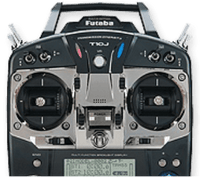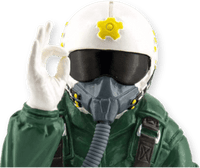How To Balance Your Airplane
by Motion RCCG or Center of Gravity is one of the most vital elements of ensuring safe flight. Every airplane has a recommended CG from the manufacturer. Usually, the CG has a +/- factor of 10 or less millimeters both fore or aft of the CG mark. This is because some people prefer to fly their airplanes a little on the nose heavy or tail heavy side depending on a number of factors.
All aircraft have a specific CG position, it's the mean point where all gravitational forces act upon the plane and hence the point where the model balances fore-aft correctly. You can think of a plane's CG like the center point of a see-saw, for example.
Methods To Balance Your Airplane's CG
High wing trainers are the easiest planes to balance and if this is your first plane then this is likely the case.
Obviously the first thing you need to do is identify the correct Center of Gravity position according to the manual. As a very general rule of thumb the CG will be about one-quarter or one-third of the wing chord (width) back from the leading edge of the wing. The main spar, if there is one, often lies in this general area.
Again, this position is only a generalization and in reality a CG point can be found anywhere from, say, 25% to 50% of the wing chord back from the leading edge. A CG point outside of that range is rare, but not impossible.
The Easy Finger Method
Most folks tend to use their finger tips to balance their airplanes. To do this, place the tips of your index or middle fingers under each wing, exactly on the line of the CG (i.e. the specified distance back from the leading edge of the wing of the plane) and a couple of inches out from the fuselage sides. Gently lift the plane up so it is clear of any surface and let it hang freely on your fingers.
Be sure your plane is flight ready when you balance it (i.e. battery pack in place, also known as All Up Weight or AUW).
A correctly balanced airplane, sitting on your fingertips, will either be level or have the nose pointing slightly downwards. If the tail points downwards then the model is tail heavy and you will want to correct that as most airplanes are less controllable tail heavy. Especially when starting out and being the first flight, you want to steer away from your model aircraft being tail heavy.
You may have to adjust your battery's position fore or aft to get the CG to the recommended point. A slightly nose-heavy aircraft - especially a warbird - is okay. As an example, if the recommended CG is 75mm from the leading edge of the wing, you might be allowed 70mm if you want the model to be slightly nose heavy. Either moving your battery forward (if your model has the space for it) or adding nose weight will achieve the nose heavy CG.
Many folks will choose to measure their CG on a low wing warbird upside down. Truth is, you can measure for CG with a low wing model/warbird either way. Some find it easier to measure a low wing warbird upside down but either way is correct as long as you measure your CG properly.
If your battery or receiver adjustment isn't allowing enough to adjust the CG (due to lack of room), you will need to add weight to either the nose area or tail area depending on where your CG is currently at. We offer weight in 1/4 ounce lead segments, which is typical in the hobby. Always remember, adding weight should be the last step after trying other methods such as moving internal parts fore or aft first.
CG Balancer
For an even more precise method to locate the CG, you can purchase a CG Balancer. Also referred to as a CG Machine, you can locate these by searching the Web. Make sure it supports your model's weight and size as there are many different size CG Machines. Refer to the instruction manual once you purchase for proper use.
Got A Low Wing Warbird With Retracts? What's The Best Method?
There is a huge debate among RC pilots concerning what the proper way to balance an aircraft with retracts is. Some suggest gear down because that is the most critical point of a flight (the takeoff and landing) when the plane is slower generally than in normal flight. However, low wing warbirds are best balanced with their gear up (since this is the normal position during flight).
Technically, a tail dragger's main landing gear on most warbirds are not too steeply raked forward, so the difference in the position of weight distribution in their "gear up" and "gear down" states is almost negligible, but it is still common practice to measure it with gear up.
So that's really it for balancing. It's a fairly easy process but critically important one that cannot be overlooked! A well-balanced airplane will be much more stable and easier to fly than an airplane out of balance. Trust us, you don't want to find out what an improperly balanced airplane flies like.
As always, happy flying AND landings!
Get the latest from Motion RC sale and product announcements
You can unsubscribe at any time!

Hobby Squawk Community Forum
visit forum
RC Knowledge Blog
visit blog
Guidance & advice for beginners
Find out more- Choosing a selection results in a full page refresh.
- Press the space key then arrow keys to make a selection.



